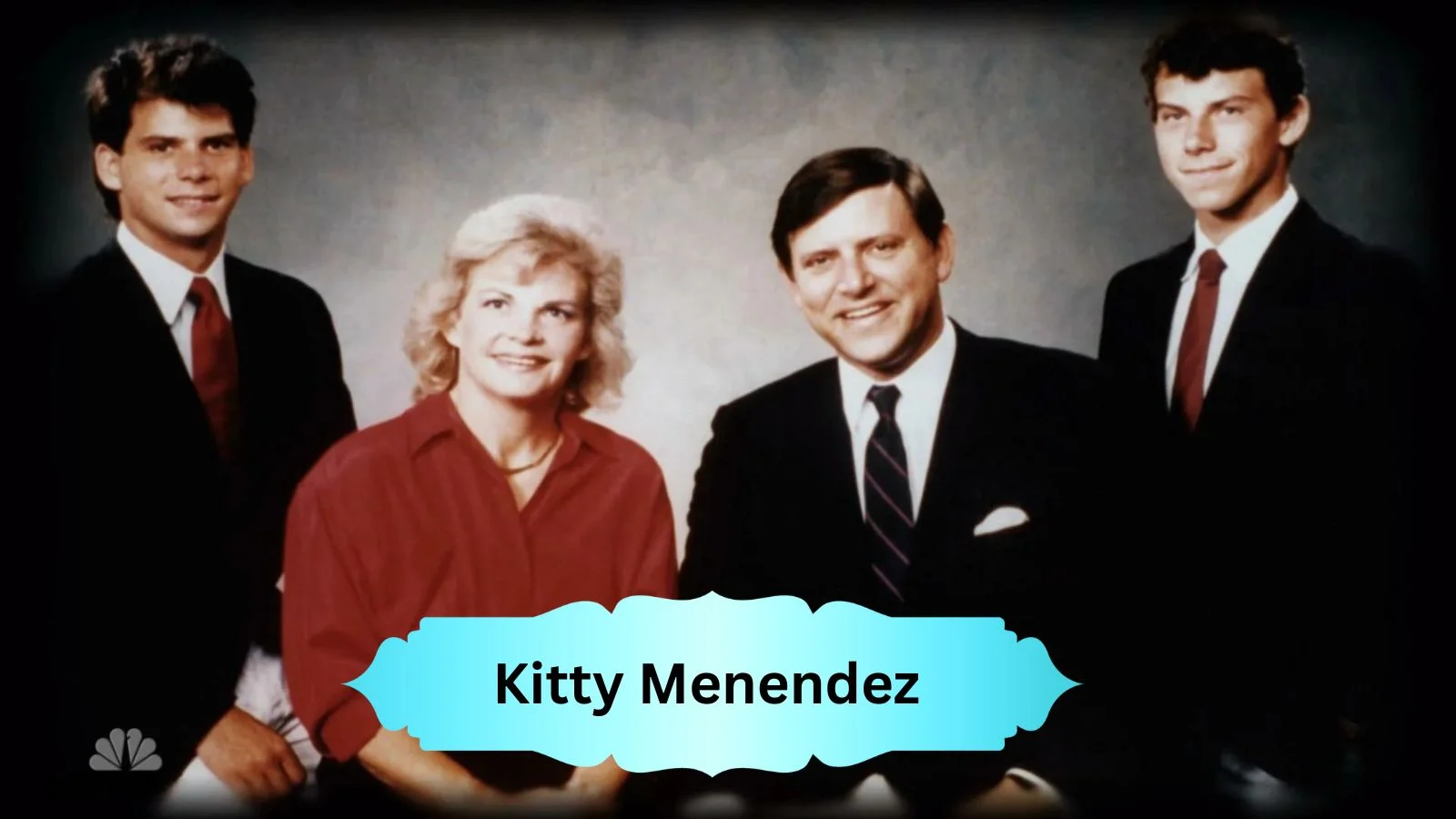The story of Kitty Menendez is one of tragedy, complex family dynamics, and a life marked by both privilege and pain. Born in Oak Lawn, Illinois, Kitty’s journey from a charming and ambitious young woman to a victim of a brutal homicide shocked the nation.
Behind the glamorous façade of the Beverly Hills mansion lay a world of emotional turmoil, marital strife, and hidden abuse. Her death in 1989 not only ended a life but sparked one of the most sensational criminal trials in American history.
This deep dive explores the woman behind the headlines, revealing the truth beyond the media frenzy. Understanding Kitty’s story is key to unraveling the full picture of the Menendez family tragedy.
Early Life in Oak Lawn, Illinois (1941–1960)
Mary Louise “Kitty” Anderson was born on October 14, 1941 in Oak Lawn, Illinois, USA, a suburban pocket of Chicago. Her father ran a heating and air-conditioning business, a stable trade in the Midwest, while her mother kept the home.
Kitty was the youngest of four children. By all accounts, she was intelligent, attractive, and athletic — a strong swimmer who once considered competing in beauty pageants. Friends remembered her as charming yet high-strung, a mix of warmth and volatility that would follow her into adulthood.
| Birth Name | Mary Louise Anderson |
| Date of Birth | October 14, 1941 |
| Birthplace | Oak Lawn, Illinois, USA |
| Height | 5′ 6″ (1.68 m) |
| Childhood Setting | Suburban Chicago |
| Family Business | Heating & Air-Conditioning |
Childhood in Suburban Chicago: Family, Friends, and First Dreams
Growing up in post-war America, Kitty’s life was marked by the typical middle-class rhythms — school, sports, and neighborhood gatherings. But under the surface, she often felt withdrawn and misunderstood.
Those who knew her in elementary school described her as socially popular yet prone to sudden mood shifts. She had an early love for acting, telling friends she dreamed of moving to New York or Hollywood.
From Mary Louise Anderson to “Kitty”: Personality and Aspirations
Nicknames can be revealing. “Kitty” became her chosen name as a teen, a reflection of the glamorous, mysterious persona she cultivated. Her goals went beyond the quiet streets of Oak Lawn — she wanted adventure, romance, and a sophisticated life.
This ambition would eventually take her far from Illinois, but it also set the stage for the contradictions she carried: a desire for stability versus a craving for excitement.
College Years at Southern Illinois University, Carbondale
In the late 1950s, Kitty enrolled at Southern Illinois University, Carbondale, majoring in communications. She was academically capable, but college life also gave her a taste of freedom — dances, debates, and road trips.
It was here that she met Jo McCord, a close friend who would later describe Kitty as “a magnetic personality, someone you wanted to be around but never fully understood.”
| Year | Event |
| 1959 | Enrolled at SIU Carbondale |
| 1962 | Competed in local beauty events |
| 1963 | Introduced to José Menendez |
| 1964 | Graduated and married José |
Meeting José Menendez in 1963: Love, Opposition, and Marriage
Kitty’s life pivoted in 1963 when she met José Menendez, a driven Cuban immigrant studying in the U.S. Their attraction was immediate, but their families opposed the marriage — Kitty’s parents saw José as too ambitious and culturally different.
Against all odds, the couple married in 1964. Kitty converted much of her life to support José’s corporate ambitions, moving with him as he climbed the executive ladder.
Cuban Heritage and the Cross-Cultural Union
José’s background — a Cuban aristocratic family displaced by Fidel Castro’s regime — brought both romance and cultural friction. Kitty adapted, learning Cuban dishes, attending formal events, and embracing parts of his heritage.
Yet privately, she sometimes felt like an outsider in his world.
Life in New York City and Queens College (1964–1970)
After marriage, the couple settled in New York City. José attended Queens College while working, and Kitty taught elementary school. These were lean years — tiny apartments, long hours, and the shared dream of “making it big.”
| Year | City | Kitty’s Role | José’s Role |
| 1964 | NYC | Teacher | Student/Part-time jobs |
| 1968 | New Jersey | Homemaker | Corporate trainee |
| 1970 | NYC | Homemaker | Mid-level manager |
Career Beginnings: From Elementary School Teacher to Homemaker
Kitty enjoyed teaching but left her career to focus on raising a family. She often expressed pride in supporting José’s path, but friends noticed she missed the independence and social life teaching provided.
Birth of Lyle and Erik Menendez: Motherhood in the Public Eye
In 1968, Kitty gave birth to Lyle Menendez, followed by Erik in 1970. She became the picture of the ideal suburban mother — PTA meetings, soccer games, and a well-kept home.
But behind closed doors, Kitty battled stress, perfectionism, and marital strain.
The Beverly Hills Move: Wealth, Corporate Ladder, and Privilege
By the 1980s, José’s corporate success (Hertz, RCA, Carolco Pictures) allowed the family to move into a $5 million Beverly Hills mansion. They lived among Hollywood elite, hosting parties and mingling with celebrities.
The move fulfilled Kitty’s teenage dream — but also amplified the pressure to maintain a flawless image.
| Beverly Hills Life | Reality |
| Designer clothes | Debt & emotional strain |
| Luxury cars | Marital infidelity |
| Prestigious schools | Strained family dynamics |
Public Image vs. Private Struggles: The Idyllic Facade Cracks
On the surface, Kitty appeared to live a dream life — but friends reported that she often seemed depressed, moody, and resentful of José’s extramarital affairs. The cracks widened when she began drinking heavily and relying on prescription pills.
Marital Problems, Affairs, and Emotional Turmoil
By the mid-1980s, the Menendez marriage was described as “strained beyond repair”. José’s infidelity was an open secret, and Kitty’s emotional volatility increased.
Some accounts suggest she had her own affairs, though friends debate their seriousness.
Prescription Pills, Alcohol, and the Spiral of Dependency
Kitty’s use of sleeping pills and alcohol escalated. In 1987, she attempted suicide, later telling a therapist she felt “trapped in a life that looked perfect to everyone but me.”
1987 Suicide Attempt and Recovery
Her recovery was partial. While she regained physical health, her mental health never fully stabilized. Friends noticed she became more isolated, often staying home with the television on for hours.
Family Life in the Late 1980s: Tensions in the Mansion
The Menendez home in Beverly Hills became a place of constant tension. Arguments between José and Kitty were frequent, and the boys — Lyle and Erik — were often caught in the middle.
August 20, 1989: The Night in Beverly Hills That Shook America
On this summer night, while watching television in the living room, Kitty and José were fatally shot with shotguns. Kitty reportedly tried to run, but was struck multiple times.
| Victim | Location | Weapon | Date |
| Kitty Menendez | Living room | Shotgun | Aug. 20, 1989 |
| José Menendez | Couch | Shotgun | Aug. 20, 1989 |
The Crime Scene: Living Room Television and Shotguns
The brutality shocked even seasoned investigators — Kitty’s body was nearly unrecognizable, a sign of the rage involved.
Police Investigation, Media Frenzy, and Public Opinion
At first, police suspected a mob hit due to José’s business connections. But suspicion shifted when the brothers’ spending spree after the murders raised eyebrows.
Trials and Retrials: Defense, Prosecution, and Key Evidence
The trials were media spectacles. The defense claimed years of abuse drove the brothers to act in self-defense. Prosecutors painted them as greedy killers seeking inheritance.
Depictions in Pop Culture: Netflix, Harper’s Bazaar, and Vanity Fair
The case has been reimagined in documentaries, TV dramas, and magazine retrospectives. Netflix’s “Monsters” (2025) renewed interest, with actors like Miles Crist and Chloë Sevigny portraying the family.
Abuse Allegations: Physical, Emotional, and Sexual Trauma Claims
The brothers alleged physical, emotional, and sexual abuse at the hands of both parents — claims that remain controversial.
The Verdict: Life Sentences Without Parole
In 1996, Lyle and Erik were found guilty of first-degree murder and conspiracy to commit murder. They received life sentences without the possibility of parole.
Aftermath: Public Perception, Legal Appeals, and Ongoing Debate
Over three decades later, public opinion is still divided: were they cold-blooded murderers or abuse survivors who saw no way out?
Remembering Kitty: Legacy, Memorials, and Lessons from the Case
Kitty was buried at Princeton Cemetery in New Jersey. Her life remains overshadowed by her violent death, yet her story raises questions about family dynamics, abuse, and the hidden lives behind perfect facades.
FAQs
Q1: Who was Kitty Menendez?
A Chicago-born former teacher and mother, best known as a victim in the Menendez brothers case.
Q2: When and where was Kitty Menendez killed?
August 20, 1989, in Beverly Hills, California.
Q3: What was Kitty Menendez’s profession?
She worked as an elementary school teacher before becoming a homemaker.
Q4: Did Kitty Menendez have a history of depression?
Yes, she struggled with depression, dependency on prescription drugs, and had a suicide attempt in 1987.
Q5: Where is Kitty Menendez buried?
Princeton Cemetery, Princeton, New Jersey.
Conclusion
Kitty Menendez’s life story is more than a tabloid headline. It’s a complex narrative of ambition, love, cultural clashes, personal demons, and family tragedy. She was a woman shaped by her era, caught between the expectations of a perfect suburban wife and her own inner battles.
Her death — and the sensational trial that followed — became one of the most talked-about criminal cases in American history, but the real lessons lie in the private pain behind public perfection.












